Hockey
Whalers Pucks
Canes Pucks
97-98
Canes Pucks
98-99
Canes Pucks
99-00
Canes Pucks
00-01
Canes Pucks
01-02
Canes Pucks
02-03
Canes Pucks
03-04
Canes Pucks
04-05
Canes Pucks
05-06
Canes Pucks
06-07
Canes Pucks
07-08
Canes Pucks
08-09
Canes Pucks
09-10
Canes Pucks
10-11
The Cup
Tailgating
Stormy
The Rebels
|
Pat's Roanoke Valley Rebels Page
What follows is my personal recollection of some very special years in my life: my early teenage years in Roanoke when I discovered the sport of hockey—the one that is, as a fan of the NHL Carolina Hurricanes—my favorite one today. All of what you read here is written from memory. There are bound to be many errors. Also, some of the stories I recount, below, are probably just urban legends. Still, at the time I heard them, I believed them and they added to the fun.
One of these days I intend to spend a week in the Roanoke Public Library going through the old newspapers and thoroughly research and write the definitive history of the Salem / Roanoke Valley Rebels. Perhaps it will all someday be published in book form. But for now I'll just tell the story as I remember it, over 50 years after the fact. Fellow hockey fans, enjoy!
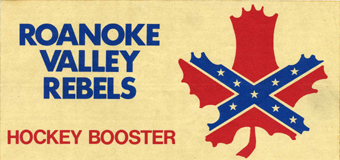
Rebels Booster Club sticker
The Roanoke Valley Rebels began playing as the Salem Rebels at the Salem Roanoke Valley Civic Center shortly after it opened in 1967. When the Roanoke Civic Center opened in 1971, they became the Roanoke Valley Rebels and played some of their games there. After the 1975-1976 season the team moved to Tallahassee and became the Tiger Sharks. Hockey continued in the SRVCC with the Salem Raiders, but to those of us who had cut our hockey teeth on the Rebels, it just wasn't quite the same.
Rebel games began with the announcer proclaiming "Here come THE REBELS!!!" and organist Kent Brown playing "Dixie" as the Rebels walked up the ramp, in skates on the rubber mat, and onto the ice. Five good looking girls in blue leotards which bore Rebels logos held the Canadian and American flags as we heard the anthems, then it was gametime. At the end, win or lose, the announcer always said "thank you all for coming, and remember to always be a Rebel Rabble Rouser!"
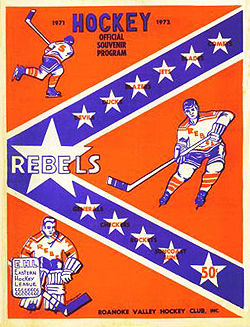
Rebels Program from 1971-72 Season
I went to my very first Rebels hockey game in the fall of 1969. I was a member of Boy Scout Troop 19 at Calvary Baptist Church and for an activity, the troop went to a Rebels game. It was against the Nashville Dixie Flyers. "Dixie Flyers" didn't fit on the scoreboard and it said the other team was the "Dixie Flys" and I was too dumb to know otherwise. I knew absolutely nothing about hockey and thought "icing" was when one of the players did a two-foot hockey stop and sprayed a cloud of ice crystals into the air.
This was my first ever visit to the SRVCC which had opened two years before. I'd heard about this building A LOT, most notably from the time in 1968 when the Four Seasons were supposed to do a concert there, but instead had gone to Salem WEST Virginia. So here I was, finally, getting to check out the place. I still have clear memories from that night. Aside from seeing my first hockey game, I also won a brand new bicycle when they drew my ticket stub. It was a fun night and I decided then and there that I loved going to hockey games.
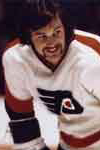 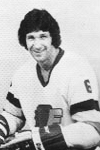
The Schultz Brothers, Dave & Ray,
both spent time as Rebels.
Soon afterward, I learned that my father's friend Mac Grisso had season tickets. Mac lived up the road from us and said he would gladly give me a ride to/from the games if I'd meet him at the end of my long driveway. So I began going with him. I continued doing this for the next four years. Mac was a character. He cursed like a sailor and had interesting perspectives on everything, e.g. "if you eat pineapple with your beans, you'll get Hawaiian music." He said all the things my dad probably would have said had he not been trying to be a father. I loved it.
That year, the Rebels were the Salem Rebels and played in the Southern Division of the Eastern Hockey League with the Charlotte Checkers, Greensboro Generals, Jacksonville Rockets and the Dixie Flyers.
As I went to the games I began to know the players. Jim Jago was the leading scorer and captain. Claude Piche led the team in goals and, with his blonde hair and blue eyes, was the one all the girls were in love with. The goalie was Jim Letcher (Mac: "Letcher's got a damn beer gut so big he can't even bend over!"). Jack Chipchase and Wayne Mosdell were the steady, workhorse defensemen. The coach was Colin Kilburn, a plump, cheeky guy who looked kind of like the Big Boy in front of the Shoney's restaurants.
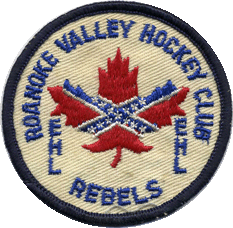
Rebels Patch
Then there was Dave Schultz. Dave was the entire package. He was big, played hard, and could make plays and put the biscuit in the basket. He was the team's second leading scorer. And best of all, Dave could fight and he did, earning 356 penalty minutes that season (an average of just over five minutes per game). Dave would go on to be a star for the Cup-winning Philadelphia Flyers teams of the mid-1970s. He earned the nickname "The Hammer" and exemplified the Flyers of that era who were known as the "Broad Street Bullies." Dave's brother Ray also played for the Rebels for a season.
The following year the Rebels got a player named Bobby Guindon. He was a French-Canadian guy whose nickname was "Ding Dong" (Mac: "Ding Dong ain't got a tooth in his head!"). He was small but was tough and once beat the crap out of the Charlotte Checkers' goon Bob Shupe. Also new were Dave Parenteau, the 1970-71 leading scorer; Dale MacLeish, brother of Philadelphia Flyer Rick MacLeish, and Ray Woit, a consistent playmaker that came from the New Haven Blades. Other regulars were August George, Bob Lacey and Don Rozich, the original Rebel.
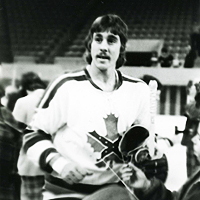 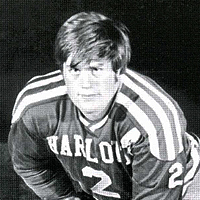
Bobby Guindon, Bob Shupe
Following the 1970-71 season, the Dixie Flyers folded and a new team, the St. Petersburg Suncoast Suns joined the Southern Division. The Jacksonville Rockets, who had finished in the basement the previous year, were even worse and were on the bad end of the worst hockey defeat I have ever seen—live OR on television. At a Saturday afternoon game I watched the Rebels hand them a 14-2 beating. Not long after this, on December 9, 1971, the Rockets folded.
The SRVCC hockey rink did not have thick sheets of plexiglass around it as today's rinks do; it was surrounded by a conduit frame with chicken wire. Because of this, players could hear everything the fans were yelling and vice versa. On one occasion some guy sneaked a whistle into the arena and during play, blew it. When he did, the players thought it was an official and stopped playing. That guy was promptly tossed out of the building. Also, the only thing separating the fans on the front row from the players' benches were a set of metal railings.
One night, some drunk on the third row was harrassing Dave Parenteau. After enduring this for half the night, Dave ran out of patience, climbed up into the stands and beat the tar out of the guy. Such was life in the old Eastern Hockey League (and it was even worse in cities where the concession stands sold beer—which they DID NOT do in the SRVCC OR the RVCC). Indeed, the classic movie
Slap Shot
featuring Paul Newman was based upon the early 1970s EHL Johnstown Jets.

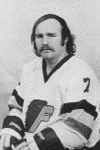
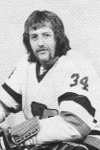
Chipchase, MacLeish & Sully
The officiating wasn't always good in the EHL, either. There was one ref named Bob Giovatti who was always earning the wrath of Rebels fans because he lived in Charlotte (home of the Checkers) and it always seemed like he was calling against us. And sometimes I think the goal judges were half asleep. One night a member of an opposing team came down the ice and cranked up a shot from the blue line. The puck beat Jim Letcher, bounced off of the center support pole in the back of the goal and right out the other side. Chipchase picked it up, took it up the ice and as he crossed the blue line, turned back to Letcher and winked at him. None of the officials noticed and naturally, none of the home fans said a word.
And there was Sam the Zamboni Man. I always heard that his whole name was Sam Monford. Sam was the thin black man who drove the Zamboni every night. We would sit in the stands and sing "Sam, Sam the Zamboni man, lives the life of leasure... the way he would resurface the ice, it would really please ya..." After a few seasons of doing this, Sam was awarded with a red jacket that said "SAM" on the back, for his excellent services.
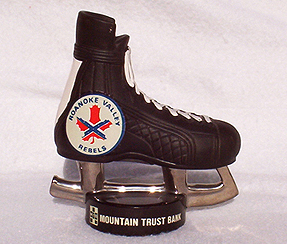
Rebels / Mountain Trust "Skate Bank"
When the 1971-72 season began the Rebels had a new goalie, Roger Kosar. Roger was big—6 feet, two inches tall—and his size made it hard for opponents to score on him. Dale MacLeish was the leading scorer, followed by Parenteau, Woit and Piche. Marty Desmerais and Edmonton native Tom Stachniak joined the team. Piche was called up to the WHL Phoenix Roadrunners for a few games. Perennial players Chipchase, Mosdell, Rozich, Pete Shearer rounded out the team which finished third in the EHL South with a 31-34-9 record (Mac: "They need to get rid of them damn 'home town' boys!").
Another guy who joined the Rebels in 1971 was Doug Carpenter. Doug had played the last six years for the Greensboro Generals and was recognizable because of his red hair. About this same time, I got my very first pair of hockey skates. Unlike figure skates, hockey skates have no teeth on the fronts of the blades and to move you have to turn your foot sideways and push with the entire blade. I could not do this to save my life, and at public skating sessions at the SRVCC I'd spend two hours clinging to the boards and falling on my ass.
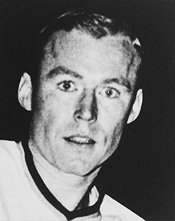
Doug Carpenter
One day, while out there slipping and sliding all over the place, I heard a voice say "You... come here." I didn't recognize him at first because he was in street clothes with glasses, but it was Doug. There had apparently been a Rebels practice prior to the session and he was still hanging around the building. He handed me a metal folding chair and said "Push this around on the ice and you'll learn how to push off with your skate blades." I took his advice and before I knew it, was skating! Doug Carpenter went on to coach the NHL New Jersey Devils from 1984-88 and the Toronto Maple Leafs from 1989 through 1991.
To begin the 1972-73 season the Rebels made a few significant changes. Kilburn moved into a front office GM job. The team became a farm team for the WHA Philadelphia Blazers. Gregg Pilling was hired as coach. Pilling had been voted the MVP for the Southern Division of the EHL as the fiery leader of the St. Petersburg Suncoast Suns in '71-'72. Kosar left for the Richmond Robins of the AHL and the Rebels had two new goalies, Danny Sullivan and Yves Archambault. Claude Piche was in the AHL now with the Baltimore Clippers so, courtesy of the Blazers, a few new forwards were added to the roster including Claude St. Sauveur, who would eventually play in the NHL for the Atlanta Flames.
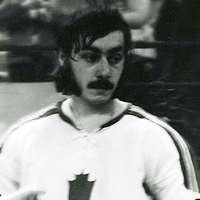
"Double 0" Archambault
Danny wore #34 and drove an old beat-up white Corvair that had a confederate flag and a big #34 painted on each door, along with the words "Sully -- Go Rebels!" He was loved by the fans and admired for playing most of the season with a pin in his leg while waiting for an off-season operation to remove it. Yves wore the number 00 in honor of his idol, former Philadelphia Flyer (and now WHA Philadelphia Blazer) Bernie Parent. The 00 was supposed to stand for the number of goals he would let in, but Bernie once said it was also for when you "were scored on and said 'oh oh!'").
That year, the Rebels could have easily been confused with the Montreal Junior Canadiens because, by the end of the year, they had seven players from the province of Quebec: St. Sauveur (St. Hyacinthe) and Archambault, Mosdell, John Hutton, Pierre Paiement, Denis Meloche, Pierre Henry, all of Montreal. Later that year they would add Michel Boudreau, whose nickname was "Boots." Many of the new players, including Boudreau, were sent down from the Blazers. The Blazers were coached by former Boston Bruin legend Johnny "Pie" McKenzie and featured former Bruin Derek Sanderson and former Flyer Andre Lacroix.
And there was Serge. Serge Beaudoin, another Montreal native, joined the team as a defenseman and became the enforcer. Serge was 6' 2" tall, weighed 215, had long brown hair and a big handlebar moustache and could take care of business. You pronounced his French name "Sairzh" but all of us dumb Virginia rednecks just called him "Surge" and cheered everytime he came on the ice because—though he was a very good defensemen and playmaker—seeing Serge come onto the ice often meant that somebody on the other team was about to get the crap beaten out of themselves.
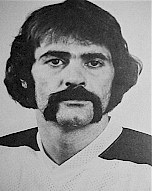
Serge
Serge was loved at home and hated on the road. There's a legendary story about a time the Rebels were playing the Generals in Greensboro. Some drunken fan is said to have gotten into one of the concession stands, where he stole a big gallon sized plastic vat of mustard. He then took it and stood over the visiting team exit in the arena and when Serge went walking off the ice, dumped it on his head. Rather than getting angry, Serge supposedly looked at his teammates and said "Maybe if we keep standing here, he'll throw down some hot dogs, too."
The Rebels won the EHL Southern Division with a 40-25-11 record in 1973. They scored 345 goals and only gave up 276. They went to the Walker Cup Finals and lost to the Syracuse Blazers. This was an interesting series. The Blazers—who I'm sure were really just a great team with a bunch of really tough guys—were promoted in the Roanoke media as being worse than Evil Empire. Their fans (we were told) bought beer in the arena, were drunken hooligans who got into fights and did things such as going into the referees' locker room and filling their street shoes with concrete.
And (we were told) the Blazers weren't much better. They were said to be dirty bastards who had put bounties on the heads of several of our players. Rebel Wayne Horne, a former Blazer, was apparently telephoned and warned of this by his old Syracuse friend Ray Addouno. Ray was the captain of the Blazers and had led the entire EHL by scoring 170 points (54 goals, 116 assists) that year. After this was reported in the Roanoke media, Ray became the one "good guy" on the Blazers. We booed the others but always cheered him.
I have since come to regard the Blazers as being a damn good hockey team. That part of New York loves and produces tough hockey players. I know! When I saw the Carolina Hurricanes win the Stanley Cup in 2006, we had a tough guy named Erik Cole from Oswego! I blame the local media for whipping us into a frenzy; I suppose it was good, as the hoopla helped pack the building during the series, but I've always been curious as to its accuracy. I've sought to contact some Blazer fans from that era to see how it looked from their side and if you are one, please drop me a line.
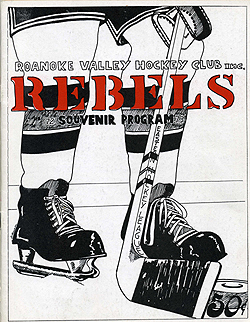
Rebels Program from 1972-73 Season
The Rebels generally played well in the series. Well, with one horrible exception. After squeaking out an inprobable 5-4 OT win in Game #1 in Syracuse, the Blazers came back in Game #2 to humiliate the Rebels 17-1. Game #3 was a bit better with the Blazers winning 7-4 but this game featured Blazer Mike Morton uncharacteristlcally manhandling Serge.
Though the Rebels won Game #4, they dropped the last two and lost the series in Salem in Game #6. It was rumored that they let it slip away so they wouldn't have to return to play a Game #7 in Syracuse. I was there when the Blazers won. They were given the Walker Cup and as they were taking turns skating around the ice hoisting it, the trophy broke and pieces went everywhere. Honest.
That particular year I signed up for youth hockey and played one season for a team called the Lions. We wore those old powder blue Pittsburg Penguin jerseys, minus the crest. The other two teams were the Warriors (orange, black, white Flyer jerseys) and the Leifs (who wore blue and red Ranger road jerseys and yes, for some reason, it WAS spelled that way...as in...Erikson?). Our team was coached by former Rebel Don Rozich, who quit midseason and was replaced by a passionate old guy named Mr. Brown. I played goalie for the first half of the season then switched to defense and scored one goal, which I remember well.
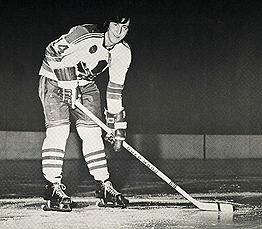
Michel Boudreau - "Boots"
The other memory that stands out from that entire hockey season is the day I got into a fight with some guy who played for the Warriors. Hell if I remember who he was. He kept hitting me on the ice and I kept hitting him back. Sooner or later one of us slugged the other (and honestly I can't remember who). Well, off came the gloves and he and I beat the crap out of each other until the linesmen broke us up and tossed us out of the game.
Problem was, in youth hockey both teams shared the same locker room. So after all of this, we had to go to the same locker room to take off our stuff. I thought surely he'd come over there and hit me again. Instead, as I walked in, he looked up and said "Well, we're both out of the game. Want to walk down to Lendy's for lunch?" We did. He was a nice guy and we talked for an hour, then headed back to the arena. Then, next game against them, just as you'd expect, we got into it again.
About this time, a small group of fans organized The Roanoke Valley Rebels Hockey Booster Club. It was run by a couple of fat girls and members congregated in a meeting room at the SRVCC during games to talk and have refreshments. I think it cost $5 to join it. One of my friends and I joined because you could go to that room between periods and eat free doughnuts. After a few weeks of this they changed the rules—you now got no refreshments unless you were over 18—because they were tired of us eating all of their doughnuts.

Gregg Pilling
That summer, several current/former Rebels held a hockey school at the SRVCC. Claude Piche was the headliner and was assisted by former Rebels Ken Miller and Bob Lacey. For one week my mother drove me to the SRVCC every morning at 8, and I spent the day doing exercise and playing hockey. One of the highlights of the week was when all of us were visited by a surprise guest, Coach Gregg Pilling of the Rebels, who talked about how the team was going to be that year.
Following the 1972-73 season the EHL ceased operations. The northern teams became the North American Hockey League. The Rebels, Checkers, Generals and Suns became the Southern Hockey League along with two new teams. The Winston Salem Polar Twins jerseys featured pictures of two hockey playing polar bears named Winston and Salem (their names on their jerseys were from the cigarrette pack logos). The other new team was the Macon Whoopees, borrowing the name from 1944 the song, "Makin' Whoopee" by Eddie Cantor (and later covered by Louis Armstrong, Ella Fitzgerald and even Willie).
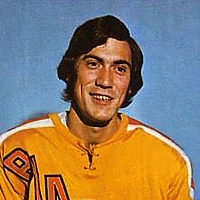
Claude St. Sauveur
The Whoopees jerseys looked like those of the Montreal Canadiens with a big rounded "M" over a rounded "W". Everytime the announcer mentioned the Whoopees (which he always sounded embarrassed to have to do), people in the crowd would yell "WHOOPEEEEEE." They were one of two teams that didn't last. The Suns folded on December 19, 1973 (my sixteenth birthday) and the Whoopees closed up shop in January, 1974. But the other teams lasted the entire season with the Rebels finishing in first place.
During the early winter months of 1974, after a snow and ice storm closed the public schools, I was spending the day with my girlfriend Debbie who lived in the Sugar Loaf subdivision of Roanoke—also rumored to be the home of Claude Piche. We looked out the window and saw three guys trying to unstick their car from the ice. Those guys turned out to be Claude, Dale MacLeish and Michel Boudreau who came in her house to call a tow truck. While waiting we all had hot cocoa. Now THAT was cool.
That year, the Rebels kicked ass. Now that we were in the six-team SHL we had no Blazers to play and that year, dominated the league. Claude Piche, who was healthy all year, led the team in scoring, came within one point of leading the entire SHL (Charlotte's Gary Swain had one more point, though Claude scored 44 goals to Gary's 33). Claude was voted the SHL MVP that year. Claude, Danny Sullivan, Jack Chipchase and Wayne Mosdell all made the SHL All-Star Team and Gregg Pilling was the Coach of the Year. Another notable guy on that team was Mike Keenan, who later would coach the NHL's Flyers, Blackhawks, Rangers, Blues, Canucks, Bruins, Panthers and Flames.
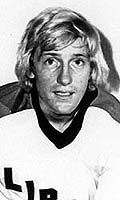


Piche, Mosdell & Paiement
The Rebels won the first Southern Hockey League Championship in two, action packed, seven game series, taking the Winston-Salem Polar Twins in the Semi-Finals and the Charlotte Checkers in the Finals. Meanwhile, in the North American Hockey League (the former Northern Division of the EHL) the Rebels' former nemesis the Syracuse Blazers swept the Long Island Ducks in four games, outscoring them in the series 27 - 5.
Following the 1973-1974 season I had discovered girls and was about to discover radio. The next year I spent most of my time hanging out at WROV and chasing girls and didn't go to nearly as many Rebels games. Had I known they would only survive as a team for two more years I would have tried to go to every single one, but when young, one tends to think that everything will last forever. But these days I cherish those memories of going to their games when I did, and, as mentioned before, someday plan on writing their history (if no one else beats me to it!).
Rebels / League Statistics
Courtesy of The Internet Hockey Database
Click the links, below, to open windows featuring the year's Rebels regular season player stats, the EHL or SHL final regular season stats and pictures, as I find them. Goalie statistics, playoff statistics and, hopefully, a summary of the events of the season and a few more photos will eventually fill out these pages. It will all depend on how much time and energy I have for research, if my wife will tolerate me making another ten trips to Roanoke so I can go to the library, if my Roanoke friends will be able to stand seeing me that much, etc. Cross your fingers and for now, enjoy what's already here.
1967-68 Rebels / EHL Regular Season Stats
1968-69 Rebels / EHL Regular Season Stats
1969-70 Rebels / EHL Regular Season Stats
1970-71 Rebels / EHL Regular Season Stats
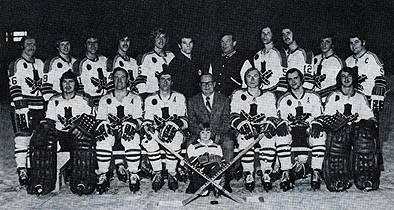
1971-72 Rebels / EHL Regular Season Stats
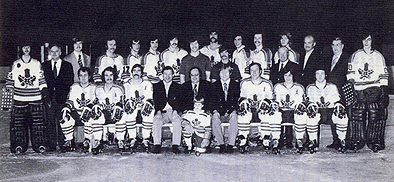
1972-73 Rebels / EHL Regular Season Stats
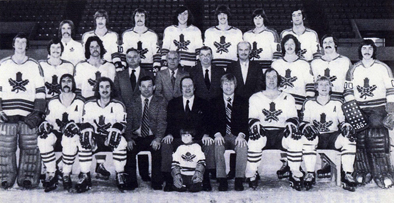
1973-74 Rebels / SHL Regular Season Stats
1974-75 Rebels / SHL Regular Season Stats
1975-76 Rebels / SHL Regular Season Stats
More Pictures
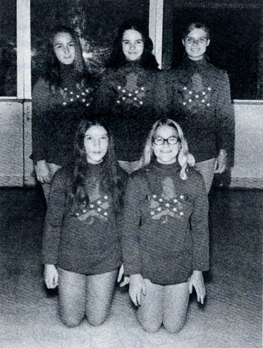
The Rebelettes
|
Organized in 1970, these lovely girls skated out with the American and Canadian flags prior to each opening faceoff while the national anthems were played. I was a teenage boy at the time and some nights I think I enjoyed seeing them more than watching the hockey game. Front: Cindy Kilburn, Cheryl Muth; Back: Gwynn Fisher, Terry Wirt, Diane Hall.
|
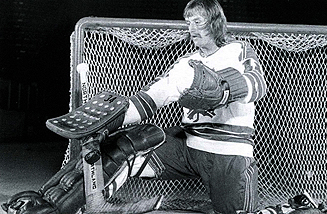
Danny Sullivan
|
Another photo of him. After a season with the Charlotte Checkers, he was a Rebel in 1973-74 and a fan favorite. He wore #34 which you see on his blocker, but in this photo for some reason he's wearing Camille LaPierre's #11 jersey.
|
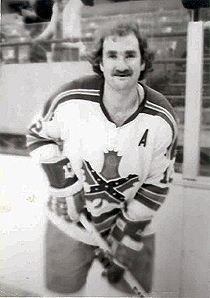 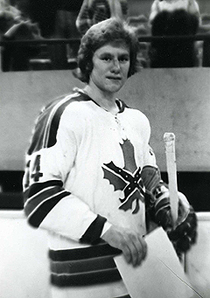
Ray Woit, Jerry Butler
|
I took these photos (also the ones above of Yves Archambault and Bobby Guindon) at a "team skate" event in 1974. The light was bad, the camera was bad, and the photographer wasn't very good, either. Ray was a Rebel for six years. Jerry had stints with the Checkers, Rebels, Suns and Generals.
|
More Rebels Memorabilia
I regularly search Ebay, ask friends, and will someday likely run a local add looking for it. As I find it I will put it here. If you have anything to donate/trade/sell, let me know.
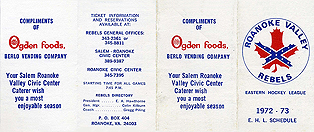
1972-73 Schedule (front)
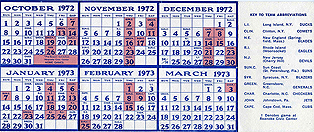
1972-73 Schedule (back)

Rebels Canvas Banner
|
Click it for enlargement of signatures. Signees include Colin Kilburn, Dave Parenteau, Jack Chipchase, Jim Letcher, Bob Lacey, Jim Jago, Bobby Guindon, Ken Miller, Jim Lorette, Wayne Mosdell, Norm Bean, Claude Piche, Don Rozich, Pete Shearer, Ray Woit and August George (he signed it from the other end so his is upside down).
|
Roanoke Valley Rebels Pucks
1970—1975
|
|
Front
|
Back
|
Description
|
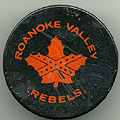
|
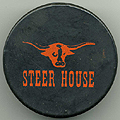
|
Rebels "puck night" puck, sponsored by the Steer House restaurant (there was one on Brambleton near 419).
|
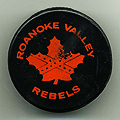
|

|
From 1974, the year the old EHL Southern Division became the Southern Hockey League.
|
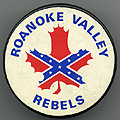
|
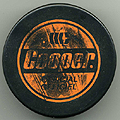
|
This one was made by Cooper, manufacturer of hockey equipment in the 1970s. It may be a fake; I bought it from some guy on Ebay and the Rebels logo looks like it was from a cut-out bumper sticker put onto the puck.
|
|

